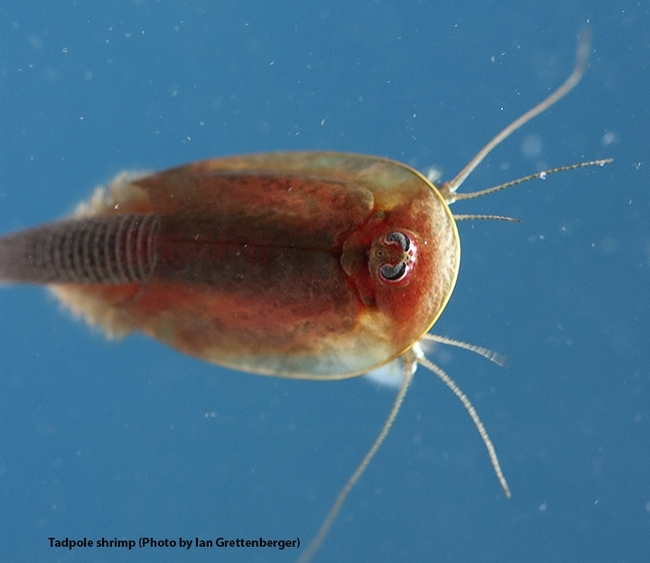
First, they're neither tadpoles nor shrimp. Second, they're crustaceans and are pests of rice.
Tadpole shrimp will be one of the topics that Cooperative Extension specialist Ian Grettenberger, an agricultural entomologist, will cover when the Bohart Museum of Entomology hosts a family friendly open house from 1 to 4 p.m., Saturday, May 28 in Room 1124 of the Academic Surge Building, Crocker Lane, UC Davis campus.
The event, free and open to the public, is themed “Bugs in Ag: What Is Eating Our Crops and What Is Eating Them?”
Grettenberger, a member of the UC Davis Department of Entomology faculty, will discuss pests of rice and alfalfa and other agricultural crops, and also will cover such beneficial insects as lady beetles, aka lady bugs.
But back to tadpole shrimp. We asked Grettenberger 10 facts that most people may not know about these critters. Here we go!
- The common name for Triops species is tadpole shrimp because they look superficially like tadpoles (frogs), but another common name is shield shrimp, named after their shield-like carapace.
- The genus name for tadpole shrimp, "Triops" comes from Latin "tri" (three) and Greek "?ps" (eye). They have two large compound eyes and a third simple eye (ocellus) used for detecting light.
- The California crop where tadpole shrimp are relevant is rice. Triops longicaudatus is an early-season pest that can damage germinating seeds.
- While the pest species Triops longicaudatus is an abundant species because it can do well in rice fields, another species in California, Lepidurus packardi (vernal pool tadpole shrimp), is endangered and relies on limited vernal pool habitats for survival.
- Triops longicaudatus carry their eggs in egg sacs, where they are kept before being deposited.
- Eggs of Triops longicaudatus typically dry out completely as rice fields are drained or pools dry. Eggs can survive for many years (10's of years) in a desiccated state, able to hatch when they are flooded again.
- Triops longicaudatus are omnivorous, meaning they eat plant material, invertebrates, and even their siblings (cannibalism!).
- Triops longicaudatus will eat mosquito larvae.
- A possible sign of a rice field full of tadpole shrimp is very murky water; as they feed and burrow on the bottom, they stir up mud and muddy the water.
- You can actually buy dried eggs of Triops longicaudatus and keep them as a pet.

“We plan to talk broadly about the pests that eat our crops and the natural enemies that help protect them,” Grettenberger said. He and postdoctoral fellow Buddhi Achhami of the Grettenberger lab will field questions. (For more information on tadpole shrimp, be sure to access KQED's Deep Look video, Tadpole Shrimp Are Coming For Your Rice. which includes Grettenberger's expertise; and the UC Statewide Integrated Pest Management Program's information about tadpole shrimp.)
Also during the Bohart Museum open house, the family activity is to make tadpole shrimp hats or puppets. "Googly eyes" will be used to imitate the compound eyes and and the ocellus, said Tabatha Yang, the Bohart Museum education and outreach coordinator.
The Bohart Museum, directed by Lynn Kimsey, UC Davis distinguished professor of entomology, houses a global collection of eight million insect specimens; a live "petting zoo" comprised of Madagascar hissing cockroaches, walking sticks (stick insects) and tarantulas; and a year-around gift shop (also online) stocked with insect-themed gifts, such as t-shirts, hooded sweatshirts, posters, jewelry, books, puppets, candy and collecting equipment.
The Bohart Museum has been closed to the public for the last two years due to COVID-19 pandemic precautions. The Bohart observed UC Davis Picnic Day by setting up displays in the hallway of the Academic Surge Building. This spring the museum is open to the public, but groups must make reservations and everyone must follow the UC Davis visitor guidelines: https://campusready.ucdavis.edu/visitors? The museum's "visiting us" page includes more information.